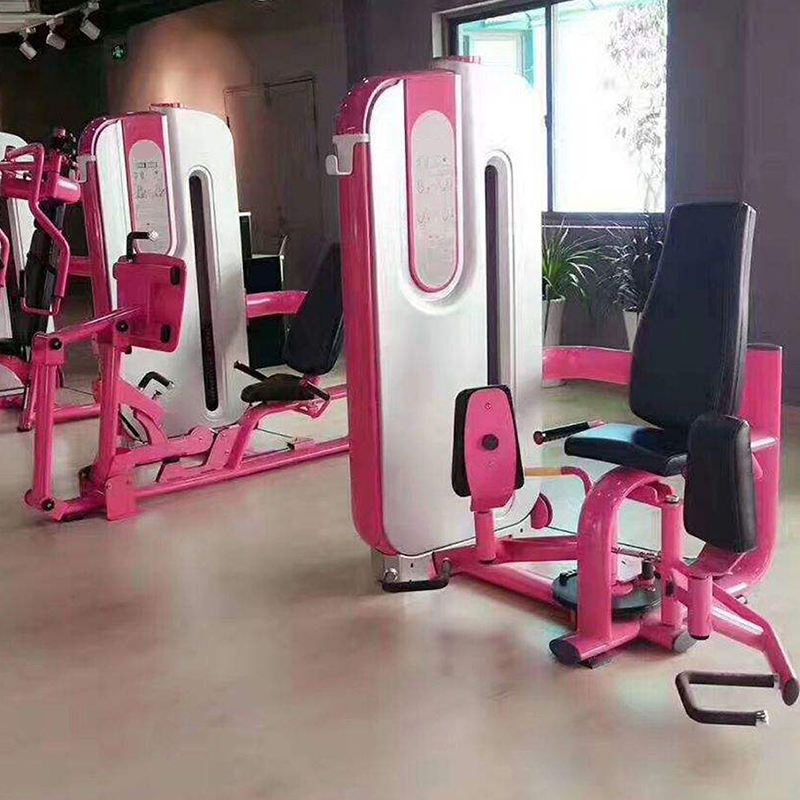A glute machine, also known as a gluteal machine or glute isolator, is a specialized piece of fitness equipment designed to target and strengthen the gluteal muscles, primarily the gluteus maximus. Here’s a detailed description of a typical glute machine:
- Design and Construction:
- Frame: Constructed from sturdy steel or alloy to provide stability and durability during use.
- Adjustable Components: Features adjustable seat and backrest positions to accommodate users of different heights and body sizes, ensuring proper alignment and comfort.
- Padding: Equipped with comfortable, padded cushions on the seat, backrest, and sometimes shoulder or chest pads to support the body and stabilize during exercises.
- Footplate or Platform: Includes a footplate or platform where users position their feet to perform the exercises.
- Exercise Motion:
- Targeted Muscles: Specifically targets the gluteal muscles, including the gluteus maximus, through a range of motion that involves hip extension and sometimes abduction.
- Movement Pattern: Typically involves pushing against resistance provided by a weight stack or plate-loaded system, moving the footplate or platform backward against resistance.
- Variations: Some machines allow for different foot positions (e.g., wide stance or narrow stance) to vary the emphasis on different areas of the glutes.
- Resistance System:
- Weight Stack or Plate-Loaded: Offers resistance through a weight stack (stack of rectangular weight plates with a selector pin) or plate-loaded system (where users load standard or Olympic weight plates onto a peg).
- Adjustability: Users can adjust the resistance by selecting different weight increments using a pin or by adding/removing weight plates, allowing for progressive overload.
- Safety and Comfort Features:
- Stability: Non-slip footplates or footrests provide stability and support during exercises.
- Safety Stop: Some machines include a range limiter or stopper to set the maximum range of motion, preventing overextension or injury.
- Handles: Ergonomically designed handles or grips may be present to assist with stability and positioning during exercises.
- Benefits:
- Muscle Isolation: Targets the gluteal muscles specifically, helping to develop strength, power, and muscular endurance in the hips and buttocks.
- Functional Strength: Improves lower body strength and stability, which can enhance performance in sports and daily activities that involve running, jumping, and lifting.
- Aesthetic Benefits: Regular use can help shape and tone the gluteal muscles, contributing to a more defined and sculpted appearance.
- Rehabilitation: Used in physical therapy and rehabilitation programs to strengthen the glutes and improve hip function after injuries or surgeries.
- Usage and Applications:
- Strength Training: Essential for individuals looking to strengthen and tone their gluteal muscles as part of a comprehensive lower body workout routine.
- Athletic Performance: Beneficial for athletes seeking to improve performance in sports that rely on lower body strength and power, such as sprinting, jumping, and lifting.
- Fitness Programs: Suitable for users of varying fitness levels, from beginners to advanced lifters, due to its adjustable resistance and ergonomic design.
- Maintenance:
- Cleaning: Wipe down the machine after each use to remove sweat and prevent corrosion.
- Inspect Components: Regularly check cables, pulleys, and weight stacks for wear and tear, ensuring smooth operation and user safety.
- Lubrication: Apply lubricant to moving parts as recommended by the manufacturer to maintain optimal performance and extend the machine’s lifespan.
In summary, a glute machine is a valuable piece of equipment for targeting and strengthening the gluteal muscles through controlled resistance exercises. It offers adjustable settings, safety features, and ergonomic design to provide effective workouts for users aiming to enhance lower body strength, stability, and muscular development.



















































Reviews
There are no reviews yet.